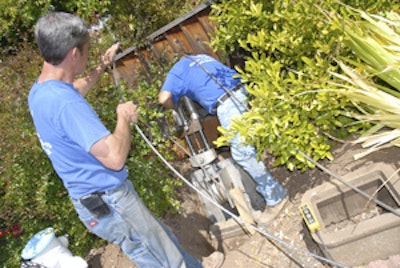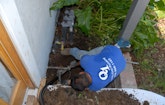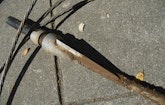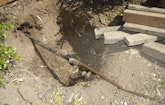
Interested in Municipal/Industrial?
Get Municipal/Industrial articles, news and videos right in your inbox! Sign up now.
Municipal/Industrial + Get AlertsPuddles alongside the front porch of a three-bedroom home in Sunnyvale, Calif., indicated a leak in the waterline. Since the spigot was dry, the homeowner assumed the problem was underground, and called Quality First Plumbing in Sunnyvale.
Technician Atanacio Francisco shut off the service at the house and utility box, then dug down 18 inches to the pipe. He found that although the ground was wet, the source of the water was not near the house.
Every inch of the yard was landscaped, leaving excavation as the last resort. Quality First owner Bob Zamaroni, a TRIC Tools affiliate for 14 years, knew the company was looking for an opportunity to test its new swaged splitter for 1-inch galvanized steel waterlines. John Rafferty, director of marketing and product support, brought the prototype to the site.
Despite stressing the PTI cable almost to the breaking point, the bursting head remained attached to the wire, broke through the couplings, and emerged in satisfactory condition with the replacement pipe.
Design concerns
Ward Carter, inventor and co-founder of TRIC, and Robert Ding, mechanical engineer, designed the splitting head. “The rule of thumb is that the diameter of the cable swage termination is twice the diameter of the cable,” says Carter. “We got around that by using a 6-inch-long swage fitting that is part of the splitting head, thus eliminating any mechanical connection between the head and cable.”
The next challenge was finding a cable strong enough to withstand the pull and still fit inside the host pipe, restricted by an average deposit of rust and tuberculation. The team settled on seven-strand 3/8-inch PTI wire, dead-tested to just under 8 tons.
“We couldn’t use a larger diameter because then the swage would be too large,” says Carter. “The toughest part of the pull would be not knowing if the wire was robust enough to withstand the pressure.”
The tool, from where the cable dives into the swage to the end of the splitting head, is more than 16 inches long. A 2-inch-long screw adapter attaches the SDR11 1-inch HPDE pipe behind the head. The pipe was approved for potable water.
The swage had to launch into the pipe straight, and the stiff wire precluded going around any bends, but the waterline connected to the house valve at a 45-degree angle. Francisco removed the fitting and enlarged the entry pit to 24 by 12 inches to accommodate the long tool.
“He barely had enough room,” says Rafferty. “The concrete porch was to his left. A low brick retaining wall with a pillar supporting the porch roof was behind him, and three irrigation lines crossed over the waterline at the point of entry.” The waterline ran 30 feet across the yard, under a fence camouflaged by flowering hedges on both sides, and to the service meter halfway to the sidewalk.
Thunk, thunk, stop
Francisco dug the 24-inch-square by 24-inch-deep pulling pit at the utility box, then removed a foot of host pipe to make room for the 2-foot-square by 1-inch-thick aluminum resistance plate, 4-by-6 wood cribbing, 10-inch pulley, and C25 ram with 25 tons of pulling force and 6.28 square inches of piston area. A 5.5 hp SPX PowerTeam 8,000 psi pump powered the ram.
While Zamaroni assembled the pulling components, Francisco shoved the plain end of the cable through the host pipe toward the pulling pit. The stiff wire moved along slowly until he heard a thunk and forward motion stopped. Francisco pulled back on the cable and tried again – with identical results.
Francisco marked the wire at the mouth of the host pipe, pulled it out, and used the length to measure the distance to the obstruction. He dug a small hole at the fence line and hit a double 90 in the pipe. “It was 12 inches from the pulling pit, but separated by the fence,” he says. “Cutting out that little surprise set us back about 30 minutes.”
The force of the pull extrudes the last eight to 10 feet of pipe ahead of the bursting head. “Normally, we remove the ram, chain-wrap the pipe, and yank it out with a truck,” says Zamaroni. “But we didn’t have room for such a maneuver on a residential street.” The trick was to stop the extruding pipe before the cable carried it through the keyhole in the resistance plate and under the pulley.
To avoid that scenario, Carter cut a 1/2-inch-wide slot in a 5- by 4-inch plate of 3/8-inch steel to fit ahead of the resistance plate and against the ground. It would catch the extruding pipe, while the cable continued through the keyhole and under the wheel.
Nail biter
To begin the burst, Francisco inserted the head into the pipe with the slitting blade down. “The 6-inch-long swage at the nose adds strength and acts like a pilot to center the tool in the pipe,” says Carter. “The inverted blade forces the ruptured metal outward like an umbrella to deflect dirt and debris.”
Zamaroni monitored the pressure gauge during the pull. “Cables, if they fail, always fail under the pulley as they go from horizontal to vertical,” he says. “That’s the point of greatest stress. To play it safe, we always deduct 15 to 20 percent of a cable’s load rating to select one strong enough to come around the wheel. We didn’t have that luxury this time.”
The pull progressed at 12 to 18 inches per minute with the pressure holding at 1,600 to 1,800 psi or 4 to 5 tons of pull. Then the blade hit the first coupling and the pressure fluctuated between 2,100 and 2,400 psi or 6.5 to 7.5 tons.
“We could see the wire strands flattening in the trough of the pulley, so we stopped and let the cable catch up,” says Rafferty. “It was good to pull slowly because we were running right on the edge of failure.”
Before the cable reached its breaking point, the blade cut through the coupling, and the pressure dropped into a comfortable range. Bursting the second and third couplings was equally as stressful.
Slow and steady
The dogleg hole enabled Francisco to watch for extruding pipe and warn Zamaroni to throttle back. When the pipe hit the stop plate, Zamaroni halted the pull and removed the plate, then repositioned the ram and resistance plate behind two 4- by 6-inch timbers. Then he eased the ram back into action, allowing the pipe to extrude into the pit as far as the pulley.
The space between the soil and cribbing provided a little window to watch for the bursting head. The galvanized pipe still attached to it went through the slot in the resistance plate and stopped just under the wheel as Zamaroni killed the power.
The team dismantled the ram, and Zamaroni grabbed the pipe and yanked it out of the hole, bringing the head and HDPE pipe along behind it. Francisco, still standing in the pit, used a 3-pound hammer to knock the pipe off the bursting head while Zamaroni hung on and pulled.
“The cable exhibited a slight helical deformation,” says Rafferty. “Corkscrewing means it was pulled harder than it wanted to be around a tight radius. PTI cable is designed only for direct pulls. We also found a 2-degree bend in the cable at the swage because we pulled the head termination just an inch too far under the wheel. However, the tool proved that it could do the job.” In four hours, the homeowner had a new waterline and his service restored.










